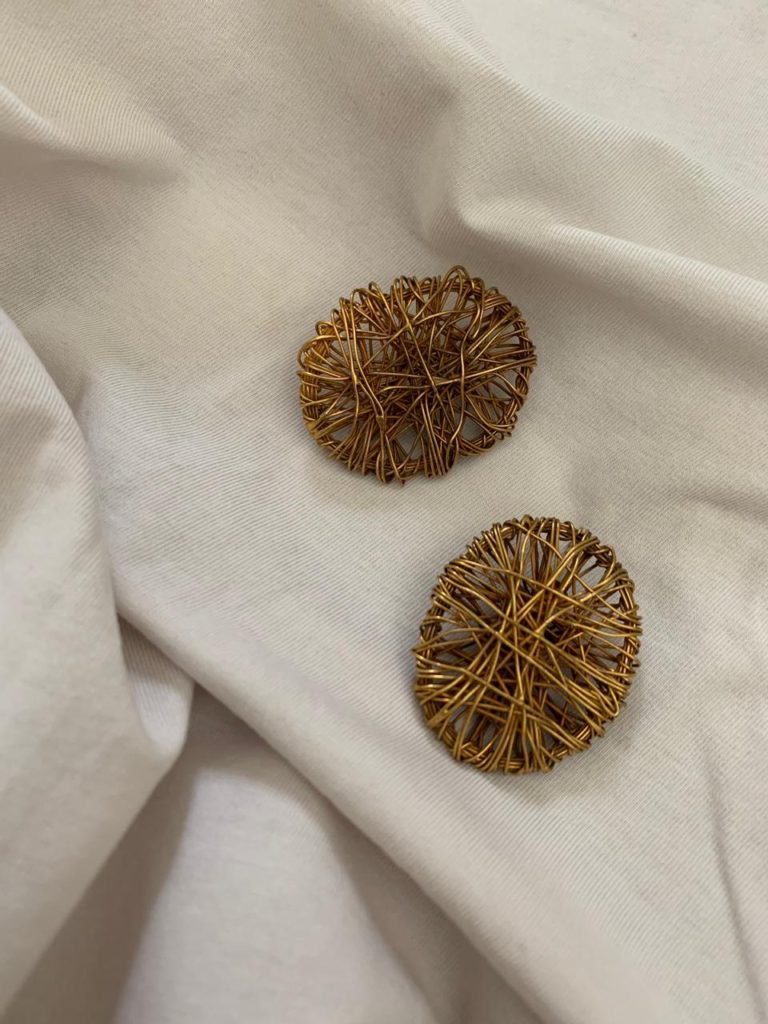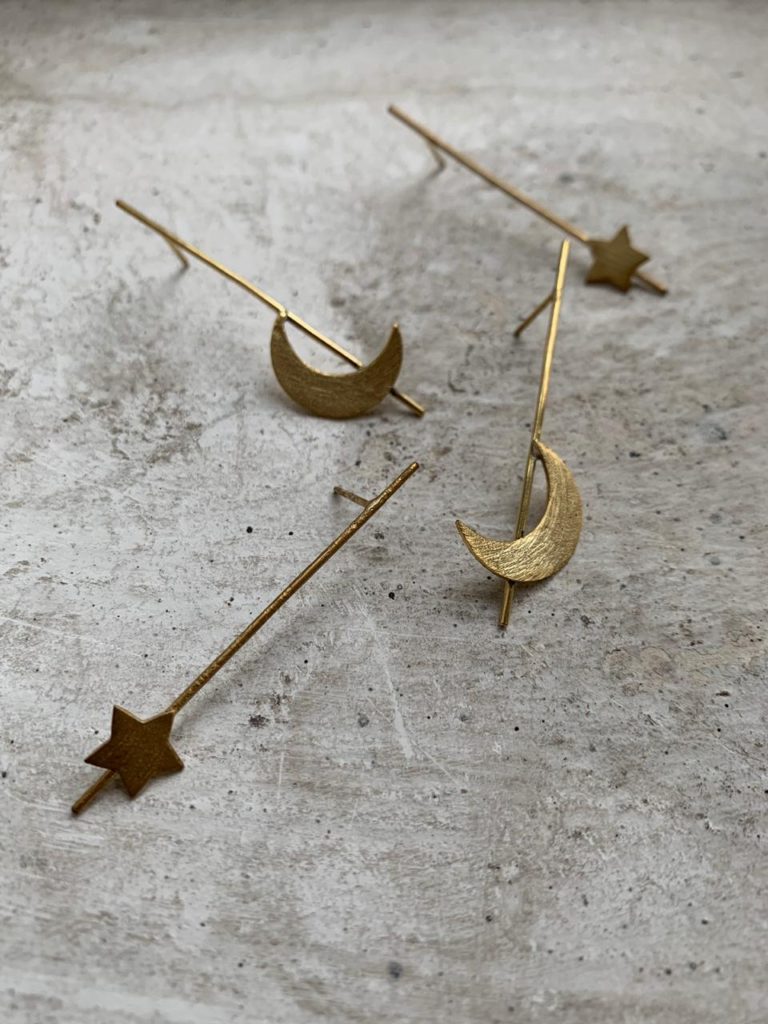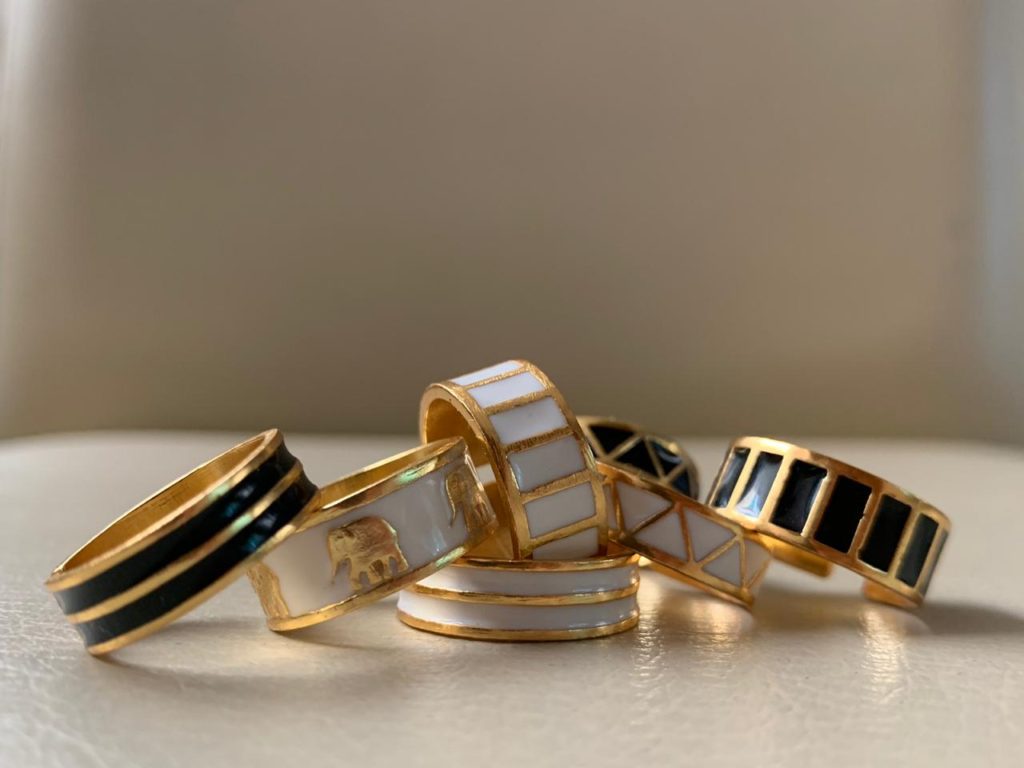We here at Designers door interviewed Aavriti Jain the founder of Dhora jewellery, their jewellery is inspired by the province of Rajasthan and is known for its bold, unique and contemporary approach towards costume jewellery designing. Get to know the unique perspective and inspiration that went into making this brand different from others with it’s cultural yet a minimal and indie approach.
Q1 – What inspired you to become a costume jewellery brand designer and what has been your experience as a jewellery brand owner?
I won’t even call myself a jewelry designer per say. I’m just a creator. Ever since I was a child it always excited me to create things. I think the satisfaction I get out of constructing an idea and executing it and making into a reality, that really sort of excites me and triggers some sort of satisfaction in me. So, it’s always been that. I guess my art form to convey my expression is jewellery, so I’ve picked up that and ever since then through Teatro Dhora which is our concept store, I’ve been playing with clothes, furniture and what not. So, I guess it’s just a medium through which I express my emotions which is jewellery.

Q2. What makes the costume jewellery at ‘Dhora’ exclusive?
If you ask me what makes it exclusive is something not what I’m chasing. What I’m chasing is to make Dhora jewellery inclusive. I feel it’s a time where you have to make your product or your story as inclusive as possible. Past a couple of years, we’ve also been seeing how fashion has become very inclusive, it should be for all age groups, it should be for all caste and color, it should be beyond any country line. So, my mission is to make Dhora jewellery inclusive instead of exclusive.

Q3. How much time goes in developing a costume jewellery collection?
The amount of time we take in making a collection is – I would like to first address that we do not work on collections. We never have. Since the time we started the company, I have never believed in making collections because I don’t think we shop in terms of seasons. Especially when it comes to jewellery, your jewellery for summers and winters is not separate. So, we’ve never worked in collections. We’ve always worked piece by piece and of course if that one motif and that’s how jewellery actually really functions, if that motif is very interesting and if it’s doing well commercially then you make it into a bracelet and then into a necklace and so on and so forth. As regards to the time, I guess the creation and the conceptualization for any artist within their mind could be going on for months or even years. But as regards to the craftsmanship, since their jewellery is all handmade it takes from, I suppose 15 to 20 days.
Q4. How do you combine the minimalistic approach to your designs which are an inspiration of the culture of Rajasthan?
So the minimalist approach to my jewellery happens very, very naturally, as I grew up as a tomboy and even now so, my personal style is very, very simple. So, I guess it’s a very natural take on things. Not just in jewellery even in clothes or the way the store is designed. I guess, an inference of culture comes again naturally because I grew up in Rajasthan. My inspiration is mostly to do with Rajasthan on my travels. And I guess when they both collide it is something rooted which is Rajasthani and that’s made into something wearable which is minimal.

Q5. How do you deal with creative blocks?
Creative Blocks are a part and parcel of any journey. I suppose if you are feeling blocked, you should take a break. It’s a signal for you to take a break which is needed in any avenue that you pick up in life. I think it’s very, very important, I personally made it a point to travel, to take a break, I think it’s also very important which is why we celebrate Sundays, even once a week you should cut off if possible, from work. I know it’s extremely difficult because in your mind as an entrepreneur you will still constantly be thinking about your work, your business and your ideas but I guess from basic administrational systems if you can take a break it really helps your creative journey so yeah, go for a vacation, take a break, watch a movie, go for theatre.
Q6. How does the design process work in the industry? How is it different from what the students are taught?
I feel when interns come and work with us, I see a very and even personally you go through a process of unlearning. Really unlearning what you learnt theoretically in specifically design schools. I guess they help you a lot of course, you can’t take that away from it, but I suppose in the real world like we discussed about collections in the previous question, in the real world those things really don’t matter. As a consumer, when you are really working and you see what the consumer really wants is that they shop from occasion to occasion. They are shopping for an event that they are going day after or for a festival that’s coming in. So, they are not really shopping season wise. And nor are they interested in your mood board. I suppose if you’re designing or if your creative journey is coming instinctively, go for it. I do not encourage people to go with storyline with every collection. I don’t even think people read all of that. Of course, the jewellery should make value to your customer and that value could inherent with the kind of pieces and what it looks like. So, I guess if it looks beautiful and if they like it, enjoy it and they make good memories wearing that piece, you made it a point. I guess that’s a very big difference that students don’t learn in college that it’s more important to think about the design and the quality and the techniques rather than mood boarding.

Q7. How can sustainability in terms of the raw materials, be taken into consideration while making costume jewellery pieces?
It is definitely true how does a costume jewellery designer or even a fine jewellery designer, making sure that the jewellery is sustainable because eventually you are working with metal or stones which are taken out from the earth which is not really cool. A year ago, we started this drive called ‘Green Dhora’ wherein we would take peoples old jewellery, so if you’ve been a previous buyer of Dhora jewellery you can return your old pieces to us and we can create your new jewellery from the same metal. So, that’s just sort of an initiative so that we don’t go and keep buying more metal and hence, we are hoping, we are sustainable this way.
One of the things that one could do if they are looking to get into costume jewellery and still be sustainable in the conscious, I suppose:
A. Make jewellery which is repeatable. Do not follow trends because I guess if you are making jewellery which your customer can wear over and over again, you are encouraging them to sort of be more sustainable anyway.
B. Of course if you can change the medium of your product and make it into something recyclable like there are wonderful brands, we’ve worked with at Teatro Dhora who are making beautiful jewellery out of old wires, out of wooden blocks and they look extremely cool and artsy in contemporary. So, I suppose one could do that too, and over all I think jewellery is very repeatable. It could go down to generations and I really hope that people start taking costume jewellery a bit seriously because I feel if kept well and if you truly love the design it could be generated to different generations of your family too.

Q8. What do you think is the key aspect for the upcoming growth in the costume jewellery market?
When I started Dhora, costume jewellery was not a big deal then, there were very few brands. We only had wedding jewellery people or fine jewellery people or jewellery manufacturers exporting outside. There was a big gap then and ever since then it’s become travelling out and instagramming where you’re travelling is more appreciated. I guess it’s not cool for people to put up a Gucci belt or an Armani bag on Instagram and flash their money. But I guess it is trending for people to take a vacation out and spam people on Instagram about that. Suppose that’s a cultural change, our generation believes in experience rather than products, so if you go hand in hand with that philosophy, costume jewellery suddenly took a big boom, because that’s something which you would carry with you when you’re travelling, whether it is destination weddings, whether it is multiple vacations in a year, so I guess because of the rise of this thought process of going with experience, costume jewellery started doing really well and I think it has a very bright future.
Q9. With the target audience becoming more inclusive of men’s jewellries, what are your thoughts on the shift of consumer needs?
Absolutely, as I said before, this question makes total sense, I guess jewellery is becoming very inclusive, there is a big demand of men’s jewellery. Up until now within India not many jewellery designers are doing men’s jewellery but there is a very big demand. So, I suppose there is a very big gap in the market, any of the students who are reading your article should take this up and I guess it’s got a very bright future. Men are coming out of the stereotypical fashion as they used to follow before and now, we have global trends for everyone and the global trend talks about it and it does encourage men to wear more jewellery, so yeah there’s a very big rise in it.
Q10. In the costume jewellery industry, how have the designs evolved over the period of time?
So the biggest change I’ve seen in terms of designing in costume jewellery is that when I was in my earlier years with working in Dhora, it was all about chunkier pieces, it was all about statement jewellery and it was all about standing out in the crowd and I guess people would come for those kind of pieces to costume jewellery brands like us because they couldn’t afford those chunkier pieces in fine jewellery. But with the coming times, I have started noticing that everyone is more into classic pieces, minimal pieces, pieces could be worn in different ways, layering pieces and I guess that’s all coming to a point because now people want more comfort, people are more conscious so they want repeatable jewellery. They don’t want to just wear a pair of earrings for one party and forget about it and I’m glad that it’s happening so because people are making more informed purchases now.

Q11. Any advice you want to give to young designers just starting out?
Lastly, I guess my advice to students would be, every single person comes up with brilliant ideas, once in a while. And everyone who you know in your class, or in your college, in your friend circle would have amazing ideas, you would too but there are very, very, very few people who would actually execute those ideas. So, I suppose the only reason why you are not doing what you really want to do is because of you, you know you are probably lazy. So, start writing down all your ideas, have a conversation within yourself, within your friend circle if you should do it too. Make sure you filter the advices or the suggestions that you get in return because that’s very important. A lot of times people lose faith in their ideas just because of the feedback they get from their friends and family. I suppose that is the moment to filter what you really want to listen, what you don’t want to listen. Have faith, go ahead and do it. When you’re young, you have very few things to lose, so even if you fail it doesn’t matter, it’s very, very important to try. So, if you have a brilliant idea, get out there and start executing.



Such a beautiful interview. Her thought process and inclusive-not-exclusive ideology is commendable. Really opened my eyes in the way I think!